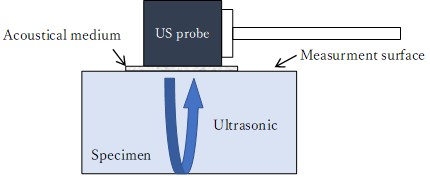The ultrasonic(US) pulse reflection method is a measurement method for determining various elastic moduli. In this method, US waves are introduced into a sample of known thickness and orientation, and the sound velocity of the sample is calculated by measuring the time difference between the first and second reflected waves. The elastic modulus (Young’s modulus and/or Poisson’s ratio) can be calculated from this sound velocity and density.
The speed of sound calculated here differs depending on the material, and the product of the speed and density is called the Acoustic impedance, which is used as an index of the ease of sound transmission, especially in the field of ultrasonic.
Since sapphire is a material with a high sound velocity (vℓ), it is one of the materials through which sound wave is easily transmitted, and its acoustic impedance value is high. Sapphire is also used as an US probe and/or an acousto-optic elements because of this characteristic.

| Material |
Sound velocity vℓ (longitudinal wave: m/s) |
Density (g/cm3) |
Acoustic impedance (×107 kg/m2・s) |
|---|---|---|---|
|
Water |
1490 | 1.00 | 0.15 |
|
Copper |
5010 | 8.96 | 4.49 |
|
Stainless steel |
5790 | 7.91 | 4.58 |
|
Fused silica |
5960 | 2.20 | 1.31 |
|
Silicon |
9850 | 2.33 | 2.30 |
|
Germanium |
5500 | 5.33 | 2.93 |
|
Sapphire (c-plane) |
11250 | 3.98 | 4.48 |
|
Diamond |
17500 | 3.52 | 6.16 |